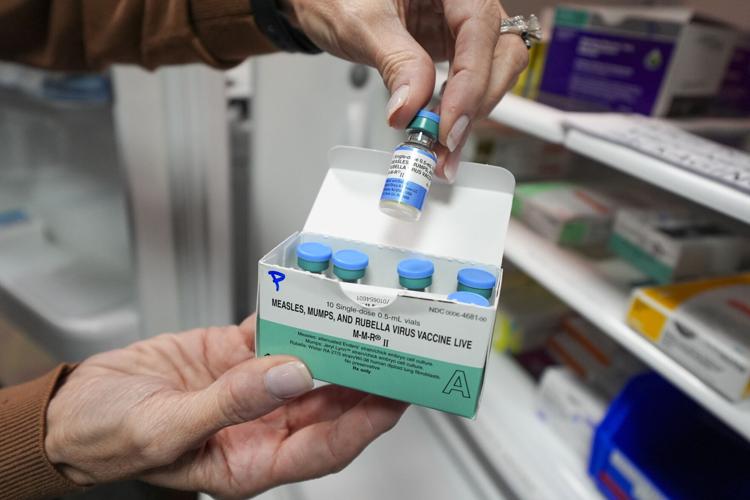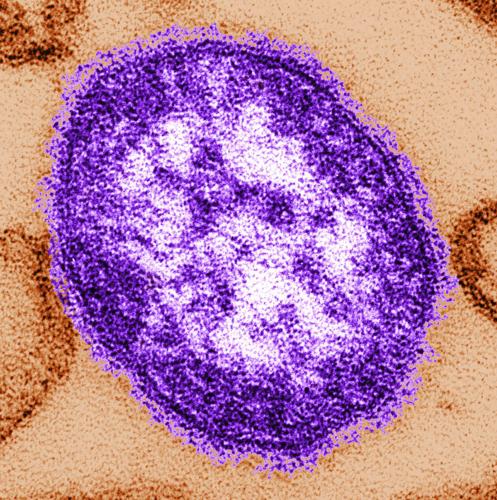
Vials of the MMR (measles, mumps, and rubella virus) vaccine are displayed Tuesday, Feb. 25, 2025, in Lubbock, Texas.
CEDAR COUNTY, Mo. — The total number of measles cases in Missouri has climbed to seven as the U.S. this week reached its highest annual measles tally in 33 years, according to the Center for Outbreak Response Intervention daily tracker at Johns Hopkins University.
The latest cases were reported in Cedar County, which is located northwest of Springfield and contains the city of Stockton. Since June 23, five people have contracted measles in the county, state and county health officials say.
All five were unvaccinated, according to an email from Lisa Cox, spokeswoman for the Missouri Department of Health and Senior Services. Two were hospitalized and later released.
Four of the cases involve one family — two children and two adults. The family reported they had isolated themselves, Cox said. However, another adult was confirmed on July 1 to have contracted the infection, likely from the family.
People are also reading…
Health officials had no information to release about places where the public may have come in contact with the latest infected individual.
“We’ve been unable to obtain any potential exposure information from the most recent case reported on (July 1) but are continuing to monitor with the Cedar County Health Department,” Cox said. “Sometimes, it is more difficult to obtain information from individuals.”

This undated image made available by the Centers for Disease Control and Prevention on Feb. 4, 2015 shows an electron microscope image of a measles virus particle, center.
Cedar County has among the lowest vaccination rates against measles in the state, with many children claiming religious or medical exemptions from school requirements. Just 74.4% of kindergarteners in the county are vaccinated, .
The best way to avoid measles is to get the measles, mumps and rubella (MMR) vaccine. The first shot is recommended for children between 12 and 15 months old and the second between 4 and 6 years old before entering kindergarten.
To keep infections from spreading, a 95% vaccination rate is needed. But among kindergarteners across Missouri, the vaccination is rate is just 90.1%, which has fallen from 94.6% in 2019, .
“Vaccine uptake continues to decrease in Missouri, making children more vulnerable to measles,” warns the state health department’s website. The immunocompromised, pregnant women and babies too young to get vaccination are especially at risk.
Vaccination rates have dropped across the country since the COVID-19 pandemic, fueling the latest increase in cases, which are mostly among the unvaccinated, according to the CDC.
A total of 1,285 confirmed cases have been reported so far this year in 38 states, . Three people have died, two whom were children, according to the U.S. Centers for Disease Control and Prevention.
This year has seen 27 measles outbreaks, which is defined as three or more related cases. Last year, the U.S. saw a total of 285 cases and 16 outbreaks, .
�Ѿ������dzܰ���’s first case was reported April 18 and involved a child who traveled to Branson from outside the country. The child was briefly hospitalized, and the child’s vaccination status was never determined.
A second case was reported May 6, involving a vaccinated adult in New Madrid County in southeast Missouri.
An infected adult from Southern Illinois caused a scare when it was determined that the adult had visited the busy ӣ����Ƶ Aquarium on April 30, but no known Missouri cases resulted from the visit, Cox said.
Measles is a highly contagious respiratory virus spread through droplets that can linger in the air and on surfaces for up to two hours after an infected person has left a space.
Symptoms develop 11 to 14 days after exposure to measles and include high fever, cough, runny nose, red watery eyes and a rash that begins on the face and spreads to the rest of the body. Anyone with symptoms should isolate and contact a health provider.
Adults unsure of their vaccination status should talk to their health provider about their concerns and options.
Measles had struck this West Texas town, sickening dozens of children, but at the Community Church of Seminole, nearly 400 congregants gathered for a Sunday service. Sitting elbow-to-elbow, they filled the pews, siblings in matching button-down shirts and dresses, little girls’ hair tied neatly into pink bows. Fathers shushed babbling toddlers as their wives snuck out to change infants' diapers. A little girl in this mostly Mennonite congregation was among those who’d fallen ill with the highly contagious respiratory disease, senior pastor David Klassen said — but she’s doing fine, and she happily played through her quarantine. He's heard that at least two Mennonite schools shut down for a bit to disinfect.













